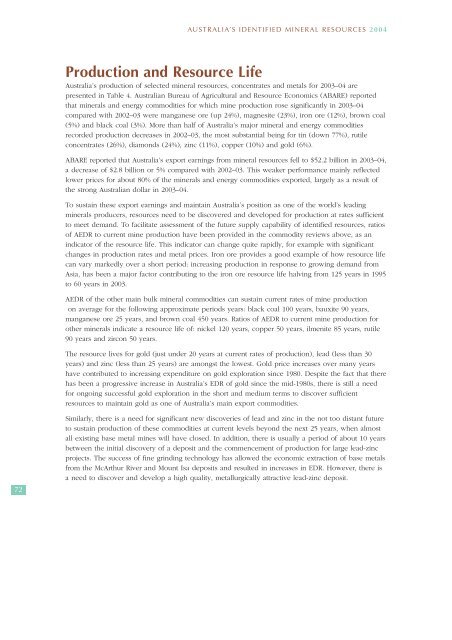australia's identified mineral resources 2004 - Geoscience Australia
australia's identified mineral resources 2004 - Geoscience Australia
australia's identified mineral resources 2004 - Geoscience Australia
Create successful ePaper yourself
Turn your PDF publications into a flip-book with our unique Google optimized e-Paper software.
AUSTRALIA’S IDENTIFIED MINERAL RESOURCES <strong>2004</strong><br />
Production and Resource Life<br />
<strong>Australia</strong>’s production of selected <strong>mineral</strong> <strong>resources</strong>, concentrates and metals for 2003–04 are<br />
presented in Table 4. <strong>Australia</strong>n Bureau of Agricultural and Resource Economics (ABARE) reported<br />
that <strong>mineral</strong>s and energy commodities for which mine production rose significantly in 2003–04<br />
compared with 2002–03 were manganese ore (up 24%), magnesite (23%), iron ore (12%), brown coal<br />
(5%) and black coal (3%). More than half of <strong>Australia</strong>’s major <strong>mineral</strong> and energy commodities<br />
recorded production decreases in 2002–03, the most substantial being for tin (down 77%), rutile<br />
concentrates (26%), diamonds (24%), zinc (11%), copper (10%) and gold (6%).<br />
ABARE reported that <strong>Australia</strong>’s export earnings from <strong>mineral</strong> <strong>resources</strong> fell to $52.2 billion in 2003–04,<br />
a decrease of $2.8 billion or 5% compared with 2002–03. This weaker performance mainly reflected<br />
lower prices for about 80% of the <strong>mineral</strong>s and energy commodities exported, largely as a result of<br />
the strong <strong>Australia</strong>n dollar in 2003–04.<br />
To sustain these export earnings and maintain <strong>Australia</strong>’s position as one of the world’s leading<br />
<strong>mineral</strong>s producers, <strong>resources</strong> need to be discovered and developed for production at rates sufficient<br />
to meet demand. To facilitate assessment of the future supply capability of <strong>identified</strong> <strong>resources</strong>, ratios<br />
of AEDR to current mine production have been provided in the commodity reviews above, as an<br />
indicator of the resource life. This indicator can change quite rapidly, for example with significant<br />
changes in production rates and metal prices. Iron ore provides a good example of how resource life<br />
can vary markedly over a short period: increasing production in response to growing demand from<br />
Asia, has been a major factor contributing to the iron ore resource life halving from 125 years in 1995<br />
to 60 years in 2003.<br />
AEDR of the other main bulk <strong>mineral</strong> commodities can sustain current rates of mine production<br />
on average for the following approximate periods years: black coal 100 years, bauxite 90 years,<br />
manganese ore 25 years, and brown coal 450 years. Ratios of AEDR to current mine production for<br />
other <strong>mineral</strong>s indicate a resource life of: nickel 120 years, copper 50 years, ilmenite 85 years, rutile<br />
90 years and zircon 50 years.<br />
The resource lives for gold (just under 20 years at current rates of production), lead (less than 30<br />
years) and zinc (less than 25 years) are amongst the lowest. Gold price increases over many years<br />
have contributed to increasing expenditure on gold exploration since 1980. Despite the fact that there<br />
has been a progressive increase in <strong>Australia</strong>’s EDR of gold since the mid-1980s, there is still a need<br />
for ongoing successful gold exploration in the short and medium terms to discover sufficient<br />
<strong>resources</strong> to maintain gold as one of <strong>Australia</strong>’s main export commodities.<br />
72<br />
Similarly, there is a need for significant new discoveries of lead and zinc in the not too distant future<br />
to sustain production of these commodities at current levels beyond the next 25 years, when almost<br />
all existing base metal mines will have closed. In addition, there is usually a period of about 10 years<br />
between the initial discovery of a deposit and the commencement of production for large lead-zinc<br />
projects. The success of fine grinding technology has allowed the economic extraction of base metals<br />
from the McArthur River and Mount Isa deposits and resulted in increases in EDR. However, there is<br />
a need to discover and develop a high quality, metallurgically attractive lead-zinc deposit.

















